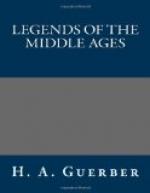There were current in those days not only classical romances, but stories of love, adventure, and chivalry, all bearing a marked resemblance to one another, and prevailing in all the European states during the four centuries when knighthood flourished everywhere. Some of these tales, such as those of the Holy Grail, were intended, besides, to glorify the most celebrated orders of knighthood,—the Templars and Knights of St. John.
Other styles of imaginative writing were known at the same time also, yet the main feature of the literature of the age is first the metrical, and later the prose, romance, the direct outcome of the great national epics.
We have outlined very briefly, as a work of this character requires, the principal features of the Arthurian, Carolingian, and Teutonic cycles. We have also touched somewhat upon the Anglo-Danish and Scandinavian contributions to our literature.
Of the extensive Spanish cycle we have given only a short sketch of the romance, or rather the chronicle, of the Cid, leaving out entirely the vast and deservedly popular cycles of Amadis of Gaul and of the Palmerins. This omission has been intentional, however, because these romances have left but few traces in our literature. As they are seldom even alluded to, they are not of so great importance to the English student of letters as the Franco-German, Celto-Briton, and Scandinavian tales.
The stories of Amadis of Gaul and of the Palmerins are, moreover, very evident imitations of the principal romances of chivalry which we have already considered. They are formed of an intricate series of adventures and enchantments, are, if anything, more extravagant than the other mediaeval romances, and are further distinguished by a tinge of Oriental mysticism and imagery, the result of the Crusades.
The Italian cycle, which we have not treated separately because it relates principally to Charlemagne and Roland, is particularly noted for its felicity of expression and richness of description. Like the Spanish writers, the Italians love to revel in magic, as is best seen in the greatest gems of that age, the poems of “Orlando Innamorato” and “Orlando Furioso,” by Boiardo and Ariosto.
Mediaeval literature includes also a very large and so-called “unaffiliated cycle” of romances. This is composed of many stories, the precursors of the novel and “short story” of the present age. We are indebted to this cycle for several well-known works of fiction, such as the tale of patient Griseldis, the gentle and meek-spirited heroine who has become the personification of long-suffering and charity. After the mediaeval writers had made much use of this tale, it was taken up in turn by Boccaccio and Chaucer, who have made it immortal.
The Norman tale of King Robert of Sicily, so beautifully rendered in verse by Longfellow in his “Tales of a Wayside Inn,” also belongs to this cycle, and some authorities claim that it includes the famous animal epic “Reynard the Fox,” of which we have given an outline. The story of Reynard the Fox is one of the most important mediaeval contributions to the literature of the world, and is the source from which many subsequent writers have drawn the themes for their fables.




